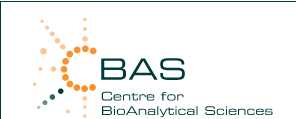-
Courses

Courses
Choosing a course is one of the most important decisions you'll ever make! View our courses and see what our students and lecturers have to say about the courses you are interested in at the links below.
-
University Life

University Life
Each year more than 4,000 choose University of Galway as their University of choice. Find out what life at University of Galway is all about here.
-
About University of Galway

About University of Galway
Since 1845, University of Galway has been sharing the highest quality teaching and research with Ireland and the world. Find out what makes our University so special – from our distinguished history to the latest news and campus developments.
-
Colleges & Schools

Colleges & Schools
University of Galway has earned international recognition as a research-led university with a commitment to top quality teaching across a range of key areas of expertise.
-
Research & Innovation

Research & Innovation
University of Galway’s vibrant research community take on some of the most pressing challenges of our times.
-
Business & Industry

Guiding Breakthrough Research at University of Galway
We explore and facilitate commercial opportunities for the research community at University of Galway, as well as facilitating industry partnership.
-
Alumni & Friends

Alumni & Friends
There are 128,000 University of Galway alumni worldwide. Stay connected to your alumni community! Join our social networks and update your details online.
-
Community Engagement

Community Engagement
At University of Galway, we believe that the best learning takes place when you apply what you learn in a real world context. That's why many of our courses include work placements or community projects.
General Analytical
Elemental Analysis
We have two systems for elemental analysis, a Microwave Plasma Atomic Emission Spectrometer ( Agilent MP-4200) and an energy dispersive X-Ray Fluorescence (ED-XRF) system. Both were acquired for the analysis of cell culture media and other materials used in Biopharma manufacturing.
|
|
 In 2006 we took delivery of an Oxford Instruments Twin-X benchtop X-Ray fluorescence spectrometer (right above). In 2006 we took delivery of an Oxford Instruments Twin-X benchtop X-Ray fluorescence spectrometer (right above). This system was used on the CBAS project to measure the mineral content of organic materials. XRF is a non-destructive technique which can be used for the analysis of solids, liquids, and thin films. The system has dual detectors for light and heavy elements. |
HPLC chromatography for Biopharma.
We have two chromatography systems which are used to support the spectroscopy based research projects. They are mostly used for measuring irreversible aggregate content in protein containing samples.
 |
This is our HPLC (Waters Alliance, donated by Boston Scientific). The HPLC is exclusively used for small molecule quantification to validate methods being developed for Low Content Quantification (LCQ) which was part of our past SSPC research activity. |
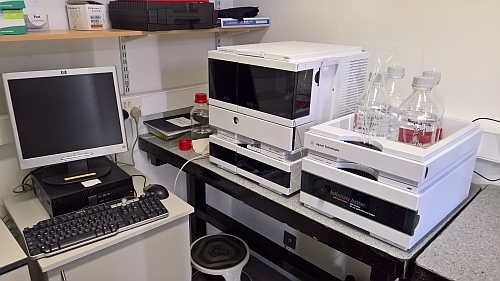 |
This is our Size Exclusion Chromatography system (Agilent 1260 with Diode Array Detector) used for protein analysis. We have several different columns available for both Size Exclusion and Hydrophobic Interaction measurements. |
General Analytical
The lab also has a wide array of general analytical instrumentation for physicochemical characterization, which exclusively supports our students and other projects.
|
Cone-Plate Viscometer We have a Lamy RM 100 CP2000 Plus viscometer in the lab to support our research into viscous, high concentration protein formulations. The system was installed in November 2025. |
 |
|
Tangential Flow Filtration: We now have (June 2025) a TFF system. It's a small scale, Cytiva, minimate Evo TFF System which we are using for both filtration and protein concentration experiments. |
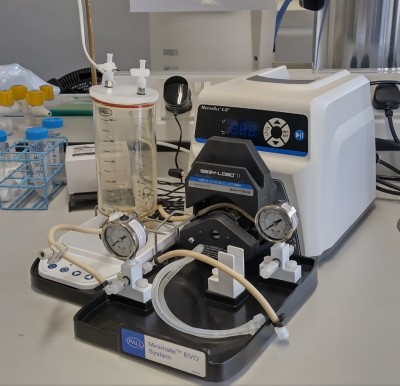 |
|
Dynamic Light Scattering (DLS) System #2 (Litesizer 500). This system has a three angle configuration with side (90), back (175)-, and forward (15) scatter angle measurement capability. This second DLS system was installed in Feb. 2025 to help with capacity issues as we now run size measurements as part of all fluorescence based testing. |
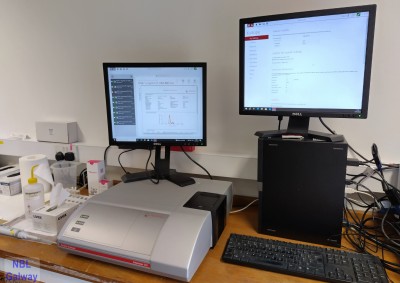 |
|
Dynamic Light Scattering (DLS) System (Zetasizer Nano ZS):
|
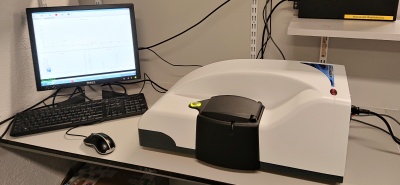 |
| Water Activity (AquaLab 4TE): A simple and effective method for checking if solid state media samples have been exposed to moisture is to use water activity measurements. This non-destructive test method is widely used for food analysis. The AquaLab 4TE system we have here operates on a dew point principle with a chilled mirror detector for detecting “free” water in samples. |
 |
| Osmometer: We have an Osmomat 3000 from Gonotec which was installed in 2017. The device measures the total osmolality of any aqueous solution which indicates the concentration of all osmotically active substances (such as salts, dextrose, proteins) per kilogram of water. The osmolality is specified in mOsmol/kg. The measurement principle is based on the freezing point depression. |
 |
| Refractometer: We have a PTR300 from Index Instruments which was delivered in May 2019. This is a 4 decimal place system for measuring refractive index at 589 nm. It can measure RI over a range from 1.32 to 1.68. This system will mostly be used for supporting biophysics measurements in the laboratory. |
 |








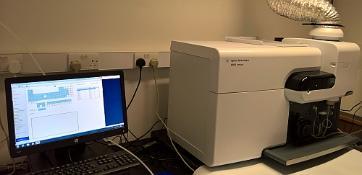 In Aug. 2017 we installed a Microwave Plasma Atomic Emission Spectrometer (
In Aug. 2017 we installed a Microwave Plasma Atomic Emission Spectrometer (